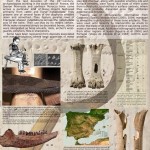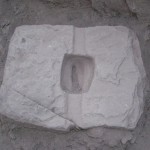Ancient Grain Farming
On the Extension of the ancient Agricultural Traditions of the Mediterranean
Archeozoologists also study bone artifacts to determine the elements of the skeleton and of what animal they are made of. In the settlements of the Abrau peninsula bone artifacts are few. Most of them are the remnants of the objects made of deer antlers. But one fragment of bone tool deserves a particular description. It presents vivid and typical traces of handling and working with this instrument and its identification was not difficult. It was easy enough to identify the raw material ‒ it was a metacarpal bone of the cattle. All sides of the bone are rasped in the way that the four planes were formed, and the bone in the section took a form of the rectangle. These planes were used as an anvil tooth to straighten a metal sickle. After straightening of the teeth the bones had distinct rows of clear «dents». Such functional reconstruction was made by Spanish archaeologists on medieval and modern ethnographic parallels. So far metacarpal bones and other bones of the cattle are used in the villages of Spain and Portugal as an anvil or «correctors» of the sickles. And the whole process of work and the appearance of traces on the bones were possible to see with one’s own eyes. The search for the center of distribution of these tools to correct finely toothed sickles brought them to the settlements between the Bronze and Iron Ages in Italy. In Eastern Europe, such bone tools are well known and quite common in the Northern Black Sea coast, but only on the monuments of antic period. In the last century they were described as “Files” for handling of the leather. But even then, this interpretation caused great doubts. After the publication of the Spanish colleagues, we can without great doubt believe that this bone tool functionally marks farming industry. And it certainly was an innovation brought by colonization of the western Black Sea coast by antique world together with habitual agricultural skills. (Catherine E. Antipina)



